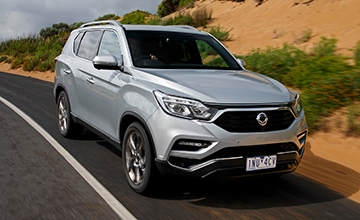
Overview
As part of the reintroduction of the SsangYong brand into Australia, one of its new offerings is the Rexton ladder-frame, seven-seat large SUV, which for now will act as the flagship model for the brand.
The completely new Rexton removes the, let’s say, divisive styling of the previous model that was offered locally, and adds versatility that the brand hopes will appeal to a wide breadth of buyers ranging from families, SUV lovers and even grey nomads.
Three variants of the Rexton are offered from launch, ranging from the petrol-powered, 2WD EX up to the flagship Ultimate – the only model in SsangYong’s line-up to breach the $50,000 mark.
Can the reborn Rexton capture the hearts of buyers the way its predecessor was unable to do?
Drive impressions
During our time in the Rexton we only drove the more up-spec ELX and Ultimate with the 2.2-litre turbo diesel and all-wheel-drive powertrain, as the 2.0-litre turbo-petrol EX was unavailable.
With the Rexton’s underpinnings shared by the Musso pick-up, it is easy to compare the two against each other. Driving them both back-to-back, it is clear that the Rexton has been positioned as the more premium offering of the two.
Entering the cabin of the Ultimate for the first time, we were pleasantly surprised by the premium features of the interior, which is luxurious enough to compete with its top-spec rivals such as the Mitsubishi Pajero Sport Exceed and Toyota Fortuner Crusade.
Swathes of faux wood trim and leather adorn the dashboard, gear lever, seats and steering wheel, while gloss black and chrome trim inserts also feature. Some cheap-looking plastics on some of the buttons are a bit of a letdown, but the Rexton’s interior is otherwise impressive.
The air-conditioning cluster adds a digital screen that shows the temperature, while a 7.0-inch central instrument cluster offers a number of different useful readouts.
While the Musso uses a 7.0-inch infotainment display, the Rexton lifts that to 8.0 inches, giving the cabin a more premium feel. However the system itself lags behind its competitors for usability and ergonomics, and the absence of a satellite navigation system even on the $52,990 Ultimate is a disappointing omission.
Apple CarPlay and Android Auto are standard on all variants so drivers should be able to avoid getting lost, but no built-in sat-nav is still frustrating.
Even the ELX has an attractive interior with a strong level of specification, including faux-leather upholstery, heated and ventilated front power seats and a 220V power outlet in the rear.
Both versions score ample levels of safety equipment, including autonomous emergency braking, forward collision warning, lane departure warning, high-beam assist, blind-spot detection and lane-change asist. The EX scores all but the last two technologies.
Headroom and legroom is ample for first and second-row passengers, however it’s a struggle to fit adults in the third row. Legroom is passable as long as your toes are tucked underneath the second-row seats, but headroom is not enough for an adult. It’s fine for kids though.
Interior space is otherwise generous, with 649 litres of space with all seven seats upright, which increases to 1806L when folding both the third-row seats and 60:40 split-fold second row.
From the outside, the Rexton is sharply styled, with a much-improved fascia that looks both muscular and attractive. With the Musso and Tivoli as other examples, it seems as though SsangYong’s designers have managed to avoid the bizarre styling of models past.
Both all-wheel-drive Rexton variants employ a 2.2-litre turbo-diesel four-cylinder engine shared by the Musso, outputting 133kW/420Nm, a boost of 20Nm thanks to the Rexton’s Mercedes-Benz-sourced seven-speed automatic transmission.
The diesel unit chugs along nicely, with plenty of torque on offer throughout the rev range. Engine performance won’t make the hairs stand up on anyone’s necks, but throttle response is sharp, engine noise is kept to a reasonable level and the seven-speed auto shifts smoothly.
Despite having an extra cog in its gearbox, the Rexton’s rpm sits at around the same as the Musso – just over 1500rpm at 100km/h, making for easy and efficient highway cruising.
During our time in the Rexton we recorded a fuel economy figure of 10.7 litres per 100km, up on the official combined figure of 8.3L/100km but similar to the rear-world numbers seen in the Musso.
One of the Rexton’s biggest selling points is its towing ability, which at 3500kg trumps any of its diesel-powered, ute-based SUV rivals, and matches the Jeep Grand Cherokee for largest towing capacity in its class.
This advantage may help it sway grey nomads looking for a towing vehicle and the driveaway pricing makes for a tantalising proposition.
While ladder-chassis vehicles provide excellent practicality and usability, it often comes at the expense of dynamics and handling. While the Rexton isn’t a Porsche 911 in the twisty stuff, it does compare favourably to its ute-based rivals.
With 10-link independent rear suspension standard, the Rexton manages to stay flat and poised through corners, while ride quality is supple considering its ability to tow 3500kg. The Rexton is also due for an Australian-specific ride and handling tune, which should further improve its on-road manners.
Noise, vibration and harshness (NVH) levels are generally sound, however in our Ultimate test car, we noticed a whistling noise coming from the sunroof, which would become annoying if it wasn’t dealt with.
Overall the Rexton should make a positive impression on Australian buyers when it lands in showrooms. The value proposition against its rivals is not as pronounced as with the Musso, however driveaway pricing along with generous standard equipment, a seven-year/unlimited kilometre warranty and seven years’ roadside assist and scheduled servicing should help ensure the SsangYong brand’s long-term future in Australia.